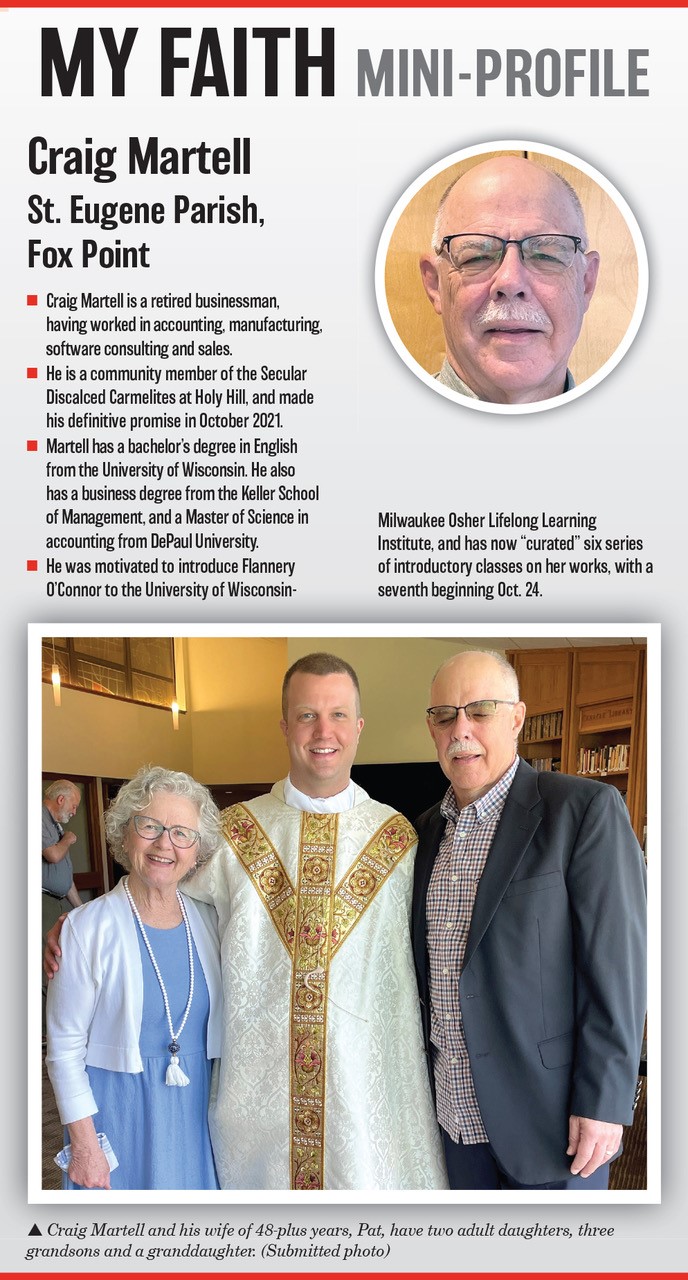Body of Christ
How did you start your relationship with Flannery O’Connor’s works?
I first encountered, but did not “get,” Flannery O’Connor as an undergraduate. I was reintroduced to her at a class on Modern Catholic Fiction at Spring Hill College in Atlanta, and then presented a short paper at the “Startling Figures Symposium” on the influence of Teilhard de Chardin on O’Connor and her writing. After we returned to Wisconsin in 2015, my interest in Flannery was reawakened by two local Catholic homilists — Fr. Jacob Strand and Fr. Aaron Pidel, S.J. — mentioning O’Connor’s works.
Do you think you “get” her now?
I believe I do. After delving into O’Connor’s short stories and occasional prose, and many of her letters for the six Osher classes I “curated” since fall 2019, my understanding of O’Connor and her works has evolved.
Why are her works so well-suited to the Osher courses?
Her stories are so relevant. She encompasses a Southern point of view — race, displaced people, gender, African American characters, secular vs. believers, believers of all kinds, etc. Her stories are short enough and digestible in bite sizes to fit into our current Osher class duration of 75-minute sessions. This model also allowed us to add targeted additional sessions. Her writing is so tight, and her characters so real, and her scenes so graphic and colorfully described, cinematic. The storylines are gripping, even shocking in many cases.
How does your faith shape your understanding of O’Connor’s works and how do her works help you defend the faith?
I am unabashedly Catholic, perhaps less so than Flannery O’Connor, but that is the lens through which I look at her stories. I am also a member, still (and always) in formation, of the Order of Discalced Secular Carmelites in a community of Carmelites at Holy Hill, so the mystical dimension of O’Connor is another focus of my interest in her. From a purely Catholic perspective, she also has the strong foundation in the Catholic faith that makes her a bulwark to go to in this contest against encroaching secularism and relativism. For me, her edge can be useful in defending the Catholic faith.
How do you contend with suffering in your courses?
As O’Connor contended with her lupus, her later writing shows a very deep vein of truth; as she wrestled with her physical decline (“passive diminishment” and “redemptive suffering”), the depth and substance of her stories intensified. Maybe that is the lesson for all of us who will inevitably face this very thing — aging, suffering, disability, death, eternity.
Will there be opportunities for individuals within the Archdiocese of Milwaukee to learn more about O’Connor in the future?
Flannery is an acquired taste, and ultimately not for everyone. For those who are interested, theatre troupe Compagnia de’ Colombari will perform a live-streamed reading of “Revelation” at 2:15 p.m. Dec. 5. The one-hour reading will be followed by a contextual conversation, moderated by a well-known O’Connor scholar, Angela Alaimo O’Donnell, and will include as participants two African American community leaders, as well as the director and an actor from Colombari, to talk about O’Connor’s life, racism, Catholicism, themes in the work relating to grace and race, north and south, as well as the making of the performance. There will also be opportunity for audience members to participate in the conversation by posting questions and comments for our panelists in the chat. Logistics are still being finalized.
Are there other opportunities to learn more?
The eighth and ninth series, which will take place in the spring and fall of 2023, will place more of an emphasis on O’Connor’s Catholicism. In the fall of 2019, Bishop Robert Barron identified O’Connor, the storyteller, as the 12th of his pivotal players, heroes shaping the Church and changing the world. There is also a PBS: American Masters Documentary, titled “Flannery,” which was executive produced by Fr. Mark Bosco, S.J., that people can watch from their homes. Fr. Bosco will be presenting with Osher this fall. There is a second documentary called “Uncommon Grace” available on YouTube.

